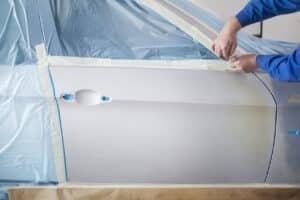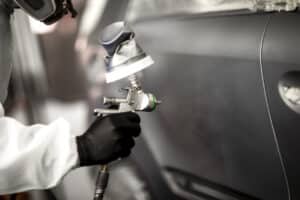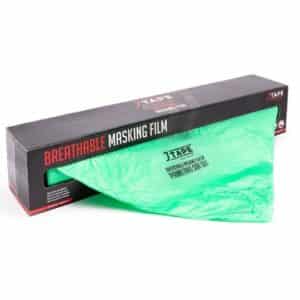Car Body Ghosting: What is it, and How to Prevent & Fix
There’s nothing more frustrating than completing a paint job on a car, only to notice blotchy stains or marks on the car body. This could mean you need to spend extra time rectifying the issue, as well as making your customers wait longer for their car to be ready.
To ensure your next paint job goes smoothly and save you the headache of any unsightly and unwanted marks, here’s our guide to what car body ghosting is, as well as other automotive painting issues to be aware of – and how to prevent them.
What is Ghosting in Automotive Painting?
So, what exactly is ghosting? It can occur in two ways, which we’ll go into in more detail later, but essentially it is a stain or marking on the car’s body. In some cases these marks can be almost invisible, while on darker surfaces they may appear more noticeable. Either way, as a professional there’s no doubt you’ll want to rectify this and prevent it from happening again.
It can sometimes be mistaken for underspray and can occur on the clear coat or paint layers, and is a common masking problem during the painting process.
How does Ghosting Occur?
There are two ways ghosting can occur. Primarily, it can happen when moisture is trapped under the masking film, which leaves marks on the paint. Water or moisture entrapment can appear between the paint finish and masking, particularly if the masking film has a low moisture transmission rate. This means the masking film is more likely to trap solvent vapour or moisture, which can result in the imprinting or marking on the car’s body surface. It’s important to ensure that paint surfaces are dry before masking, and making sure you use the right kind of masking film that will help to prevent the appearance of ghosting.

A second way that ghosting occurs is during the removal process of badges, logos and emblems from a car. It can be common to see ghosting as the clear coat underneath is preserved really well, while the surrounding coat may be oxidised and creates a contrast. This means, even though you have removed the badge, you can still see its outline on the car’s bodywork. For further advice on removing and replacing car emblems or logos, you can check out our how-to guide on the subject.
How to Remove Ghosting from Car Paint
Removing ghosting from a car’s paintwork can be tricky as you don’t want to ruin the surrounding paint on the car’s surface. However, in many cases you will likely need to touch up the paint over the ghosting marks once you’ve removed them from the car.
Using a light rubbing compound can help to remove ghosting, as it is commonly used for correcting paint scratches. The rubbing compound will remove a thin layer of the top coat, so be wary around paint edges or where the paint may be thinner. You may then need to polish the area to finish it off and ensure it looks good as new.
In some cases you may be able to reduce the imprinted marks using heat. Curing lamps, heat guns and paint booth heaters can all be used to shrink ghosting on a car’s paint.
Other Automotive Painting Issues to Note
As well as ghosting, there are a number of other automotive painting issues to be aware of, as these can all cause unnecessary headaches during the painting process.

- Marring – this is a term commonly used when a shiny or polished patch on painted surfaces has been exposed to abrasion, leaving fine, light scratches. It is known as marring when it happens below the surface of the paint.
- Clouding – this refers to irregular stripes, spots or other shapes in the paint, once you have applied the finishing coat. It can also cause abnormalities in the paint colour. It can happen due to the uneven distribution of the paint when spraying.
- Silver halo effect – during spot repairs, particularly when using silver or metallic paint, a halo effect can occur where the two paints look visibly different. This usually occurs when the wrong technique has been used to blend in metallic paints.
- Solvent pop – solvent popping occurs when the trapped solvent begins to expand and breaks through the paint. It can look like blisters on the paint’s surface, and can be caused by incorrect spraying viscosity or pressure, as well as the surface layer drying too quickly for the solvent to evaporate.
- Overspray – this is a very common painting issue, and is created by the mist caused when spray painting the car’s surface. The paint particles in the mist sit on top of the clear coat, and can be seen and felt when you touch the paint surface.
Preventing Ghosting with JTAPE
Prevention is much easier than rectifying the problem when it comes to ghosting. Luckily, our JTAPE products can help to avoid a number of painting issues. Ghosting can be avoided by making sure the paint surfaces are dry before masking, but if you do need to mask over freshly cured surfaces, it’s crucial to use a masking film that has the right properties.
Our JTAPE Breathable Masking Film is moisture absorbent, which means you can mask damp surfaces without the risk of ghosting marks. The absorbent nature of the Breathable Masking Film stops the moisture from becoming trapped. What’s more, the Breathable Masking Film is also corona-treated, which means it can hold paint or mist overspray to avoid paint contamination – helping you to achieve the neatest possible finish.

At JTAPE, we’re big advocates of trying to make life that little bit easier when it comes to achieving the best finish possible on a variety of jobs, all while increasing your efficiency. Our range of masking films and other products are perfect for a range of different applications and uses. To find out more about choosing the right masking film, check out our blog.


